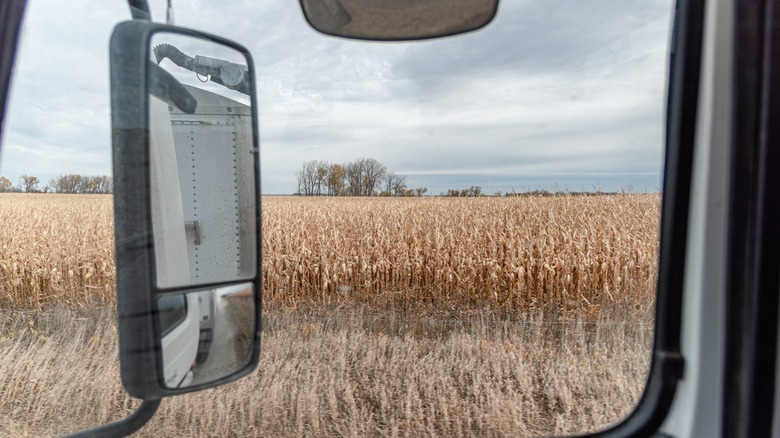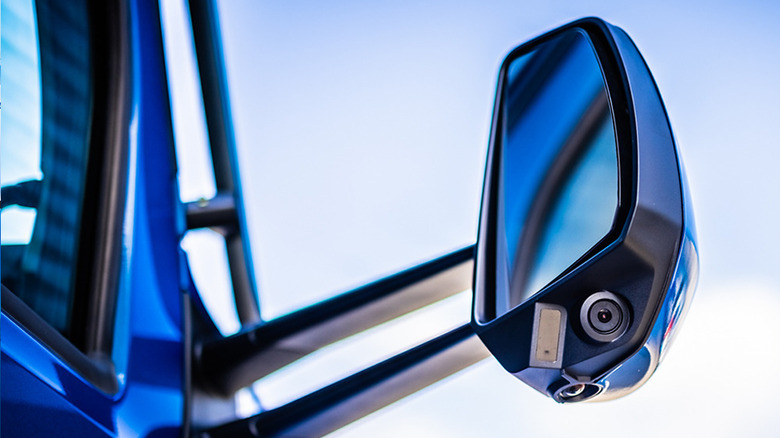Why Do Semi Trucks Have So Many Mirrors?
Every traditional automobile has at least three mirrors visible from the driver's seat: the rearview mirror above the dashboard and the two side view mirrors outside the driver and passenger-side doors. For a regular car, these few mirrors are generally sufficient for checking blind spots, giving you a clear view of what's immediately behind you and to your sides without moving your eyes too far from the road. However, if you were driving in a massive semi truck, just those three mirrors wouldn't be anywhere near enough to keep you and other motorists safe.
Compared to regular cars, semi trucks have far more mirrors positioned in and around the cabin. Not only that, but these mirrors take on a handful of distinct shapes and sizes, somewhat removed from the more-or-less uniform shape of car mirrors. While it all may seem a bit excessive, this is actually the bare minimum necessary for a truck driver to cover their large vehicle's many blind spots. All of these mirrors, when properly installed and adjusted, give a truck driver a full picture of who's driving near them, ensuring they don't accidentally run someone off the road when turning or merging.
More mirrors are necessary to cover a truck's many blind spots
On a regular car, the usual three mirrors are positioned in such a way that most of your blind spots are covered. With a quick glance and some proper driving smarts, you can always see whoever's around you and maintain proper defensive driving technique. This doesn't work for a semi truck, though. For one thing, a semi truck's rear is usually obscured, so a dashboard rearview mirror wouldn't do anything. Regular side view mirrors, meanwhile, are too small to properly reflect the truck's full length.
To give a semi truck driver proper spatial awareness, semi trucks are usually equipped with three different types of mirrors: side view mirrors, convex mirrors, and extended-length planar mirrors.
A semi truck's side view mirrors are similar to a regular car's, installed right outside the driver's side door. The difference is that these side view mirrors are far longer vertically, which allows them to reflect the entire space alongside a truck's lengthy body. These can be swapped out with wide-angle mirrors if the driver needs a little extra view space.
Convex mirrors are small, round mirrors usually installed on the fender or hood of the truck. These mirrors have rounded, concave reflections, showing a little bit more of what's on the truck's sides. This helps to further cover blind spots, particularly regarding what's coming up on adjacent lanes on the highway.
Extended-length planar mirrors are mounted on one or both sides of the cabin, similarly to side view mirrors. These mounts on these mirrors are extended further out than usual, which helps the driver to see to the back of their load. This is vital for making wide turns or merges while accounting for the load's movement.
Traditional mirrors are gradually making way for cameras
Traditional mirrors have been keeping semi truck drivers and those around them on the road safe for decades. It's more or less a solved science, which might be why some engineers have been looking to take the concept in a different direction. In the last few years, some truck brands and drivers have opted to replace their traditional multi-mirror setups with camera-based setups, also known as "digital mirrors." A digital mirror system utilizes several cameras positioned around the truck cab, with footage fed directly to a bank of monitors in the cabin.
For example, truck manufacturer brand Kenworth started offering its DigitalVision system in 2021. This system still mounts two traditional side view mirrors outside the cabin, but attached to those mirrors are a handful of high-definition cameras that provide approximately the same field of view that mirrors normally would.
The major appeal to these kinds of setups is that it's easier to see footage on a monitor bank in the cabin than trying to crane your neck to see reflections in a convex mirror or extended-length mirror. Kenworth's cameras also have manual controls if there's a particular spot on the road you want a better look at. Besides those perks, there are other various benefits, such as better vision in low light, hydrophobic camera lenses that repel water, and generally wider fields of view. There have even been claims that removing mirrors in favor of digital systems improves fuel economy, as fewer mirrors means reduced aerodynamic drag. It's a very interesting technology, one that could even reach regular cars someday.


